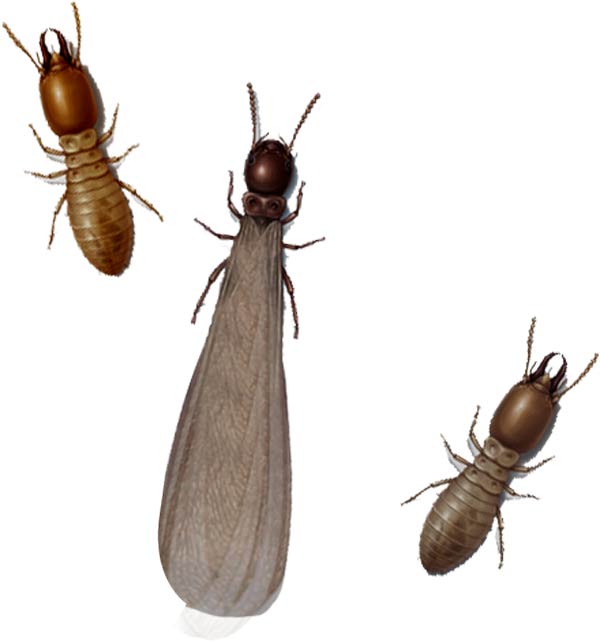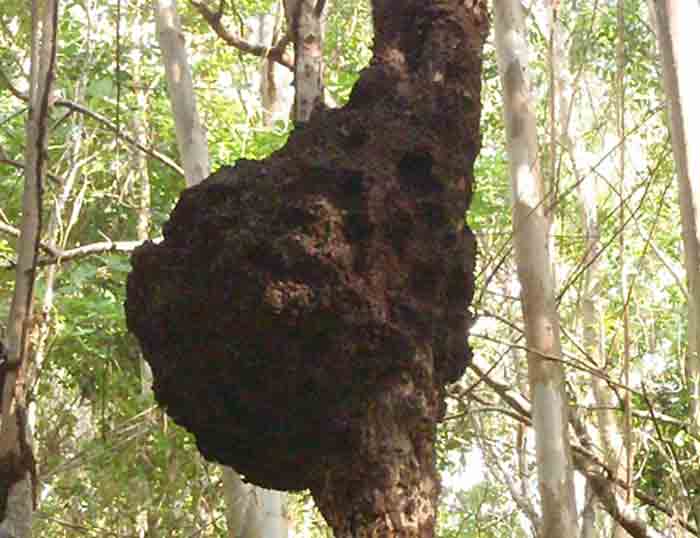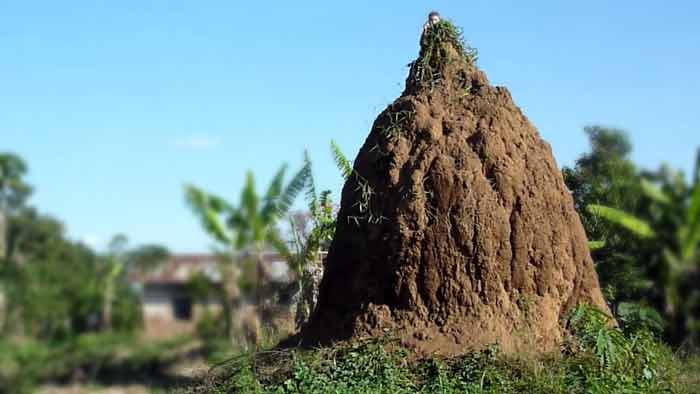Studies on termites continue to be carried out all over the world. Here are some facts and frequently asked questions what exactly termites are, types, where they come from, where they live, what they eat, and the kind of noise they make.
Table of Contents
What are Termites? Are they Insects?
Termites are small insects with a soft body and they are found to live in colonies.
Termites constitute the approximately 90000 different insect species that is found to live in the United States.
Termites are therefore insects since they have the major features of an insect. The body of a termite is divide into three distinct sections; the head, thorax and abdomen.
Like many insects, termites have three segments on their thorax each with a pair of legs. You will also notice that the wings of a termite are located on the thorax.
Of all sections of the termite, the abdomen is the largest. All these effects confirm the classification of termites as insects.

Where do Termites come from?
If you wish to address any concerns related to termites, you must first of all know where exactly the termites come from.
As you’ve already seen from the previous discussion, in most cases, the different types of termites are given names based on their habitats, and what they feed on.
However, there are other known causes and attractants that may make these insects visit your home
There are termites that come from the ground and they are in most cases referred to as subterranean termites. Other termites come from rotten and dry woods as well as timber. These termites are hence called dry wood termites.
Habitat-Where do Termites live?
Generally, these insects live in dark areas where there is no direct exposure to air. Termites live in various places based on the type of termite and the conditions it requires to survive. Below are some of the habitats;
Crevices of your home
Termites love to hide in crevices around your home or on wooden structures. This habitat is for dry wood termites.
You will discover that they create a nest to serve as a home in these crevices. It is in these crevices where they lay eggs and multiply top many more destructive insects.
Trees
Another habitat for the dry wood termites is in the tree crevices. This is similar to the above discussed home for the termite apart from it is now away from your house.
Underground
This is the home for the subterranean termites. Living on the ground gives this type of termite an advantage over the dry wood termite in that it can withstand a wider range of temperatures. More specifically, the termites live on damp soil.
Walls of a building
This habitat is for Formosan type of termites. They get to the wall of your building and create mud nests. Although the Formosan termites eat a lot of wood, they do not actually live on the wood.[1]
What do termites eat?
Majorly, the termites’ diet must constitute of cellulose. Cellulose provides termites with all the nutrients they need to survive.
This explains why termites chew through wood. Wood comes from plants and the main component of plants’ cell walls is cellulose.[2]
You must keep in mind, therefore, that termites will eat through anything likely to have cellulose. Nevertheless, the cellulose has to be dead or decaying. Termites do not eat live trees.
Below are a few of the cellulose containing items that termites eat;
Plywood
This refers to various cuts of wood put together. It therefore contains cellulose and termites will always find their way to get to this cellulose. The only time termites will not feed on plywood is if it is pressure- treated.
The paper lining the sheetrock wall
The front of a sheetrock is made of cellulose. This makes it excellent food for termites. You must however note that the termites do not eat the sheetrock itself. The insects eat the outer layer and go on with further search for more cellulose.
Particle board
This board is made up of different types of wood. This explains why termites love the particle board. It is found to be a favorite food for the termites which love damp places. This is because of its ability to swell and attract moisture.
Do termites eat cedar?
Although termites get plenty of cellulose from wood, they do not feed on all types of wood. Some of the wood types that termites do not eat include; bamboo and red wood.
Cedar cannot be classified as one of such woods since; although termites do not eat cedar at first, they eventually do. When the wood breaks down and begins to decay, it becomes attractive to termites.
Can you hear termites-do they make Noise?
Termites make noise. The sounds they produce can be classified into three as discussed below;
A dry rattle
This is the type of sound produced by termites when they are disturbed. They react to the disturbance by banging their heads on the walls of the tunnels they create on woods. The bang creates the rattling sound which you can hear with your human ears.
You must however remember that the termites do not hear audible sounds but rather they feel vibrations which are what they actually react to.
Papery rustling
As explained by the State of Florida’s Department of Agricultural and consumer services, dry wood termites may tunnel close to the surface of the wood. As they make movements, they produce a sound described as paper rustling.
Hollow sound
This is the sound you hear once you tap the wood inside of which there are termites. Unlike the above discussed sound, this once is relatively more audible.
As the name suggests, it is the sound produced due to the hollow nature of the wood. After the termites eat the wood to get the cellulose, they leave the wood with a space.
This sound is used in many cases as a way of finding out if there are termites or not. If you tap the wood and hear the hollow sound, it is a confirmation that there are termites infesting the place.
Types of Termites
Serritermitidae
Just like the rhinotermitidae, the serritermitidae family is very like to build nests in the ground.
One feature that make them unique is the mandibles of the soldiers which have serrated teeth-like projections on the inside.
South America is the only region in the world where this family is thought to exist.
Termopsidae
This family is made up of the dampwood termites which, in terms of size, are among are among the largest termites in the planet. In length the are as long as 25mm. Only about 20 species are known to exist. They are found in Australia, Africa, Eurasia and in the Americas.
kalotermes flavicollis
This is family consist of one of the most popular termite: the dry-wood termite. The prefer to stay above the ground where they can find damp and rotten wood to feed on.
Worldwide, at least 400 species of dry-wood termites are thought to exist. This family is survives everywhere except in the Antarctica.
Rhinotermitidae-Subterranean Termite
The Rhinotermitidae is basically of the subterranean termite family. They share a number of behaviors with the family serritermitidae. For instance, similar to the serritermitidae, rhinotermitidae build nests that maintain contact with earth
Termitidae
Termitidae is the beneficial type of termites especially in the desert ecosystem.
It consists of the nasutiform termite family which does not cause damages to homes.
According to entomologists, termitidae family is known to be one of the most prolific animals in the animal kingdom, each produces over 10 million eggs annually.
One salient feature of this family is its ability to build of huge mounds. Statistics show that some of these mounds are as high as eight meters.
Formosan Termites
This species is known to damage a variety of structures and they are found all over the world from California, Arizona, New Mexico, eastern Texas, Arkansas, Louisiana, North Carolina and Florida.
Further Reading: Formosan Termites Pictures, Signs Treatment & Damage
Hodotermidiae
Grass-harvesting termites is the name by which this family is known. They are similar to the dampwood termites.
They stretch to about 15mm and has 15 species found in the savannas of India, the Middle East, and Africa.
Mastotermitidae
This family is made up of the most primitive species of termites and it is found only in Northern Australia and Papua New Guinea.
Further Reading
Appearance, Size & Color
Below, find out a detailed discussion on how exactly these insects look like
- What termites look like in the human eye
- (Size)How big/small they are
- What color termites are
- Bugs or insects that look like termites
- Flying Termites with Wings (Swarmers)
- Termite Droppings
Termite Mud tubes
Termite mud tubes are tunnels that are the size of a pencil and are usually found near the termite nests, stone foundations, wood structures, and concrete.
The mud tubes are also referred to as tunnels or galleries. The components of these structures are wood, soil, termite droppings, and termite saliva.
There are different reasons the termites construct the mud tubes;
- It protects the termites from attack by predators
- It keeps the termites away from dry environments
- It serves as a travel channel from the food source back to the nest[3]
Termite Mounds/Nests
A termite mound is solid-looking yet a very porous termite structure. It is a structure consisting of many small holes that make the structure permeable.
Termites make it this way to allow for proper aeration to reduce chances of suffocation. It is a home constructed by termites using dung, soil, and termite saliva. The termites work together to build beautiful cities that are incredibly beyond a single termite’s ability.
Termite mounds provide several benefits to the termites as discussed below;
It is responsible for controlling temperatures
You realize that termites that construct the mounds are those living in areas faced with extreme temperatures.
Even with the unavoidable temperature fluctuations, the soil making up the mounds takes the role of a heat sink. The soil surrounding the mounds therefore ensures that the temperature to which the termites are exposed to barely changes.
It helps in moisture control
Some termites survive under moist environments. Such termites build mounds to preserve moisture especially when they are approaching the dry seasons. The mounds trap the required moisture very efficiently.
They serve as the lungs for the colony
Research shows that the mounds allow the colony to breath. The termites structure the mounds in such a way that they can trap small air currents.
Air that moved at a low frequency is slowly pushed into the mound by the force of the wind. The air that is already stale is sucked out by the air difference between that in the mound and in its surrounding.[4]
Your house is not safe from the possibility of termites forming a nest in them. If your house is dark or damp in most cases, you will see that the termites start building nests on the walls of your house. This could either be in the inside or outer side of the house.
Termites target wooden materials that are in your house. They use the nests as resting places as well as travel tunnels to the wooden materials in your house. This scenario is worse in the case where the whole house is a wooden structure.
are termites decomposers
More Termites Facts & FAQs
You can learn more about termites by studying the several facts discussed below;
Termites live in colonies
A mature termite colony usually has various feeding and nesting sites. You can found millions of termites make up a single colony. Termites feed on wood in order to build their colonies.
They decomposers & beneficial
Termites are pest to home owners yet very beneficial ecologically. Termites are helpful since they act as decomposers.
When termites break down decaying trees, plant fibers, and dead trees; new soil is formed. Termites improve the soil through aeration as they tunnel on the ground.
It is the microorganisms in the gut of termites that helps them, digest cellulose
Cellulose, as earlier discussed is the source of main nutrients to the termites. For the cellulose to be beneficial to the termites, it must be broken down.
Cellulose is however one of the toughest plant fibers. Loaded with microorganisms, the gut does the work of breaking down cellulose perfectly.
Termites engage in trophallaxis
This is the practice of feeding on each other’s feces. When termites are born, they do not contain all the bacteria in their gut. To obtain a sufficient supply of microorganisms in their gut, the termites must feed on each other’s feces.
Termites lived 130 million years ago
Descending from a cockroach like ancestor, termites are given as the oldest example of the mutual behavior of organisms.
The only termites that need eyesight are reproductive termites
Soldiers and termite workers are found to be blind most times. These termites have no need for developing functional eyes since most of the times; they are confined in the dark and damp nests.
Reproductive termites however require proper eyesight so that they can fly and find mates as well as new sites to construct their nests.
It is the termite soldiers which give a signal to the colony in case of a threat
When the soldiers realize that there is a threat, they send signals inform of vibrations by banging their heads against the walls of the gallery. As earlier discussed, termites are sensitive to vibrations since they do not hear sounds.
Termites are fastidious about their grooming
This means. Termites are always well groomed despite spending most of their time in dirt. Termites always make effort to keep each other clean.
Termites never sleep
These insects are active all through. This is what makes them extremely destructive. They have been found to destroy about 600000 structures belonging to the residents of the United States.
Damage caused by termites is ranked among the costliest to remedy
In the United States, residents spend over $5 billion every year in attempt to control termites from causing extreme damage.
The damage caused by termites is even greater than that caused by natural storms and fires.
Further Reading
Termites Damage, Pictures, Signs & Repair Cost
Signs of Termites Infestation-How do you know if have you termites?
Termite Inspection Cost, Procedure, how long it takes & Training
Termites resemble ants
If you wish to identify a termite, then knowing that they have similar features with ants may be helpful.
However, termites have a closer relation with cockroaches as they are said to share their ancestry.
Further reading: Ants vs termites
Termite Control
Below are details on how to get rid, kill, treat and prevent termites
- How to Get Rid, Kill Termites + Treatment Cost
- Best Termite Sprays-Orange Oil (DIY), Boric Acid & Spectracide Reviews
- Termite Tenting & Fumigation- Cost, Preparation, Safety & Cleaning After
- Termite Baits, Stations & DIY Traps
- Termite Barriers (Shields): Types, Cost, how they Work & Products
- How to Prevent Termites-Tips to Protect your Home
- Termite Bond Cost, Benefits
References
[1] https://pestworldforkids.org/pest-guide/termites/
[2] http://www.lsuagcenter.com/topics/environment/insects/termites/biology/what-do-termites-eat
[3] https://www.terminix.com/blog/education/termite-structures-101-what-is-a-mud-tube
[4] https://creation.com/termite-mounds

